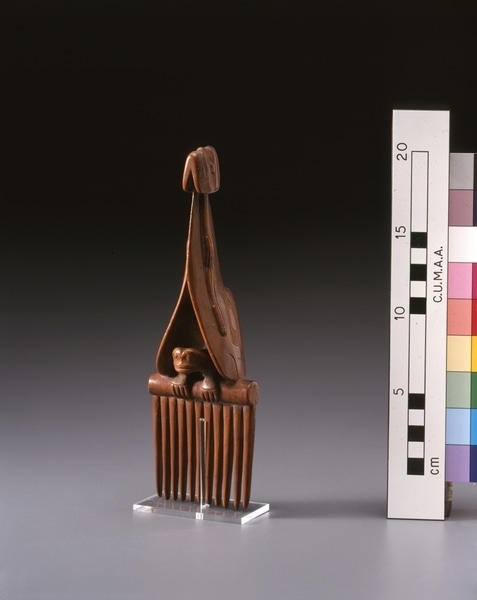Comb Item Number: 1925.370; D 1912.36 from the MAA: University of Cambridge

Description
Carved wooden hair comb with a frog design perched on a rounded crossbar from which the teeth of the comb descend. The frog sits between two sides of a raven' s head whose long beak stretches upwards to a tip. The rear of the frog can be seen from the opposite side. Held in the raven' s beak, and following its length is a humanoid figure whose arms and legs are clearly visible at the sides of the beak. The humanoid head with prominent eyebrows projects, rather mask-like, from the tip of the beak. Along one side of the raven' s beak the words Queen Charlotte are visible.; Good.
Context
Exhibited: On display in James Cook and the Exploration of the Pacific in Bonn (28 August 2009 - 28 February 2010), Vienna (10 May - 13 September 2010), Bern (7 October 2010 - 13 February 2011). Loaned Out: Fundacion La Caixa, from 28/09/1999, for exhibition in Barcelona (05/10/99 - 09/01/2000) and Madrid (01/02/2000 - 02/04/2000), 'Spirits of Water. Art from Alaska and British Columbia'; returned 07/04/2000. Jonathan King suggested that the pencil inscription on the handle of the comb in an eighteenth century hand of Queen Charlotte Is , may argue for a later acquistion than Cook's third voyage and suggests it was probably acquired on the voyages of Capt. George Vancouver 1791- 95 or George Dixon 1785-88. He syggested the comb is probably made ofyellow cedar (Cupressus nootkatensis) or alder (Alnus rubra). From notes March 2015Exhbited: On loan to 'Arctic Ambitions: Captain Cook and the Northwest Passage', at the Anchorage Museum, Alaska, 27 March- 7 September 2015; and the Washington State Historical Museum Tacoma/Seattle 16 October- 10 January 2016
Item History
- Made in Queen Charlotte Islands (Haida Gwaii), British Columbia, Canada
- Received from Denbigh, Rudolf Feilding, David Pennant, Joseph Banks ? and Cook Collection during 1912
What
- Name
- Comb
- Identification Number
- 1925.370; D 1912.36
- Type of Item
- comb
- Material
- wood and alder wood ?
Who
- Culture
- Haida
- Received from
- Denbigh, Rudolf Feilding, David Pennant, Joseph Banks ? and Cook Collection
Where
- Holding Institution
- MAA: University of Cambridge
- Made in
- Queen Charlotte Islands (Haida Gwaii), British Columbia, Canada
When
- Acquisition Date
- during 1912
Other
- Keyword
- Personal Adornment; Magic and Religion